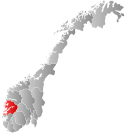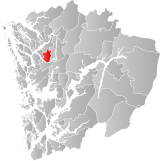Haus, Norway
Haus Municipality Haus herad | |
|---|---|
| Hougs herred (historic name) | |
 View of Hausvik | |
 Hordaland within Norway | |
 Haus within Hordaland | |
| Coordinates: 60°27′11″N 05°29′45″E / 60.45306°N 5.49583°E | |
| Country | Norway |
| County | Hordaland |
| District | Nordhordland |
| Established | 1 Jan 1838 |
| • Created as | Formannskapsdistrikt |
| Disestablished | 1 Jan 1964 |
| • Succeeded by | Osterøy and Arna municipalities |
| Administrative centre | Hausvik |
| Area (upon dissolution) | |
• Total | 96 km2 (37 sq mi) |
| Population (1963) | |
• Total | 10,843 |
| • Density | 110/km2 (290/sq mi) |
| Demonym | Hausing[1] |
| Time zone | UTC+01:00 (CET) |
| • Summer (DST) | UTC+02:00 (CEST) |
| ISO 3166 code | NO-1250[2] |
Haus (historically Hougs) is a former municipality in the old Hordaland county, Norway. The municipality existed from 1838 until its dissolution in 1964. The 96-square-kilometre (37 sq mi) municipality encompassed the southern half of the island of Osterøy as well as the area across the Sørfjorden from the island to the east, south, and west (although the municipality was quite a bit larger when it was first created in 1838). The administrative centre was the village of Haus, where Haus Church is located.[3]
History

The parish of Haus (historically spelled "Hougs") was established as a municipality on 1 January 1838 (see formannskapsdistrikt law). On 1 January 1870, the northeastern half of the municipality (population: 2,062) was separated from Haus to form the new Bruvik Municipality. The split left Haus with a population of 4,229.[4]
During the 1960s, there were many municipal mergers across Norway due to the work of the Schei Committee. On 1 January 1964, the municipality of Haus was dissolved. The part of Haus municipality that was situated on the island of Osterøy was transferred to the new Osterøy Municipality and the remaining part of Haus (on the mainland) formed the new Arna Municipality.[4]
Name
The municipality (originally the parish) is named after the old Haus farm (Old Norse: Hauss) since the first Haus Church was built there. The name is identical with the word hauss which means "skull". It is likely referring to the shape of a nearby mountain. Historically, the name was spelled Hougs.[5][6]
Government
During its existence, this municipality was governed by a municipal council of directly elected representatives. The mayor was indirectly elected by a vote of the municipal council.[7]
Mayors
The mayors (Nynorsk: ordførar) of Haus:[8]
- 1838–1839: J.C. Hammer
- 1840–1845: Julius Christopher Hansen
- 1846–1847: Johannes O. Veseth
- 1848–1851: J.C. Hammer
- 1852–1853: Ole J. Borge
- 1854–1857: J.C. Hammer
- 1858–1859: C. Jul Hammer
- 1860–1861: Anders J. Sandvig
- 1862–1863: Peter Jebsen
- 1864–1869: John L. Rognved
- 1870–1873: E. Meier
- 1874–1875: Mons J. Vevle
- 1876–1885: John L. Rognved
- 1886–1895: Ole J. Veseth
- 1896–1904: Magne J. Rognved
- 1905–1907: Ole J. Mjelde
- 1908–1910: Magne J. Rognved
- 1911–1919: Anders O. Sundland
- 1920–1925: Johan E. Rognved
- 1926–1934: Anders O. Sundland
- 1935–1937: Johan E. Rognved
- 1937–1937: Johan Garnes
- 1938–1940: G. Adolf Andersen
- 1945–1945: G. Adolf Andersen
- 1946–1947: Nils Garnes
- 1948–1951: Henrik A. Holsen
- 1952–1955: Hjalmar Romslo
- 1956–1964: Johannes Holmefjord
Municipal council
The municipal council (Heradsstyre) of Haus was made up of 37 representatives that were elected to four year terms. The party breakdown of the final municipal council was as follows:
| Party name (in Nynorsk) | Number of representatives | |
|---|---|---|
| Labour Party (Arbeidarpartiet) | 17 | |
| Conservative Party (Høgre) | 4 | |
| Christian Democratic Party (Kristeleg Folkeparti) | 5 | |
| Centre Party (Senterpartiet) | 3 | |
| Liberal Party (Venstre) | 6 | |
| Local List(s) (Lokale lister) | 2 | |
| Total number of members: | 37 | |
| Party name (in Nynorsk) | Number of representatives | |
|---|---|---|
| Labour Party (Arbeidarpartiet) | 17 | |
| Conservative Party (Høgre) | 2 | |
| Christian Democratic Party (Kristeleg Folkeparti) | 6 | |
| Farmers' Party (Bondepartiet) | 3 | |
| Liberal Party (Venstre) | 5 | |
| Local List(s) (Lokale lister) | 4 | |
| Total number of members: | 37 | |
| Party name (in Nynorsk) | Number of representatives | |
|---|---|---|
| Labour Party (Arbeidarpartiet) | 16 | |
| Conservative Party (Høgre) | 1 | |
| Christian Democratic Party (Kristeleg Folkeparti) | 7 | |
| Farmers' Party (Bondepartiet) | 3 | |
| Liberal Party (Venstre) | 5 | |
| Total number of members: | 32 | |
| Party name (in Nynorsk) | Number of representatives | |
|---|---|---|
| Labour Party (Arbeidarpartiet) | 13 | |
| Conservative Party (Høgre) | 1 | |
| Communist Party (Kommunistiske Parti) | 1 | |
| Christian Democratic Party (Kristeleg Folkeparti) | 5 | |
| Farmers' Party (Bondepartiet) | 1 | |
| Liberal Party (Venstre) | 8 | |
| Local List(s) (Lokale lister) | 3 | |
| Total number of members: | 32 | |
| Party name (in Nynorsk) | Number of representatives | |
|---|---|---|
| Labour Party (Arbeidarpartiet) | 10 | |
| Communist Party (Kommunistiske Parti) | 2 | |
| Christian Democratic Party (Kristeleg Folkeparti) | 7 | |
| Farmers' Party (Bondepartiet) | 1 | |
| Liberal Party (Venstre) | 4 | |
| Local List(s) (Lokale lister) | 8 | |
| Total number of members: | 32 | |
| Party name (in Nynorsk) | Number of representatives | |
|---|---|---|
| Labour Party (Arbeidarpartiet) | 15 | |
| Farmers' Party (Bondepartiet) | 2 | |
| Liberal Party (Venstre) | 8 | |
| Joint List(s) of Non-Socialist Parties (Borgarlege Felleslister) | 7 | |
| Total number of members: | 32 | |
| Note: Due to the German occupation of Norway during World War II, no elections were held for new municipal councils until after the war ended in 1945. | ||
See also
References
- ^ "Navn på steder og personer: Innbyggjarnamn" (in Norwegian). Språkrådet.
- ^ Bolstad, Erik; Thorsnæs, Geir, eds. (9 January 2024). "Kommunenummer". Store norske leksikon (in Norwegian). Foreningen Store norske leksikon.
- ^ Store norske leksikon. "Haus" (in Norwegian). Retrieved 23 April 2014.
- ^ a b Jukvam, Dag (1999). Historisk oversikt over endringer i kommune- og fylkesinndelingen (PDF) (in Norwegian). Statistisk sentralbyrå. ISBN 9788253746845.
- ^ Rygh, Oluf (1910). Norske gaardnavne: Søndre Bergenhus amt (in Norwegian) (11 ed.). Kristiania, Norge: W. C. Fabritius & sønners bogtrikkeri. p. 3+4.
- ^ Rygh, Oluf (1898). Norske gaardnavne: Forord og innledning (in Norwegian). Kristiania, Norge: W. C. Fabritius & sønners bogtrikkeri. p. 53.
- ^ Hansen, Tore; Vabo, Signy Irene, eds. (20 September 2022). "kommunestyre". Store norske leksikon (in Norwegian). Kunnskapsforlaget. Retrieved 1 January 2023.
- ^ "Ordførere (oversikt)". Bergen byleksikon (in Norwegian). 21 May 2013. Retrieved 24 June 2023.
- ^ "Kommunevalgene og Ordførervalgene 1959" (PDF) (in Norwegian). Oslo: Statistisk sentralbyrå. 1960. Retrieved 16 February 2020.
- ^ "Kommunevalgene og Ordførervalgene 1955" (PDF) (in Norwegian). Oslo: Statistisk sentralbyrå. 1957. Retrieved 16 February 2020.
- ^ "Kommunevalgene og Ordførervalgene 1951" (PDF) (in Norwegian). Oslo: Statistisk sentralbyrå. 1952. Retrieved 16 February 2020.
- ^ "Kommunevalgene og Ordførervalgene 1947" (PDF) (in Norwegian). Oslo: Statistisk sentralbyrå. 1948. Retrieved 16 February 2020.
- ^ "Kommunevalgene og Ordførervalgene 1945" (PDF) (in Norwegian). Oslo: Statistisk sentralbyrå. 1947. Retrieved 16 February 2020.
- ^ "Kommunevalgene og Ordførervalgene 1937" (PDF) (in Norwegian). Oslo: Statistisk sentralbyrå. 1938. Retrieved 16 May 2020.
External links

